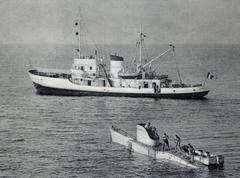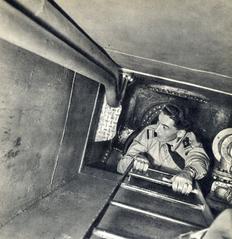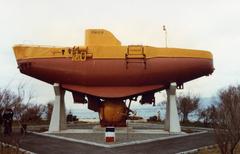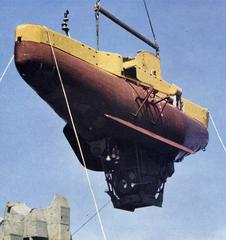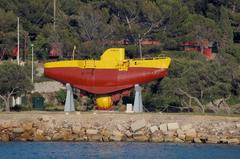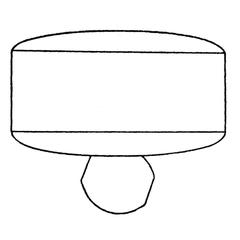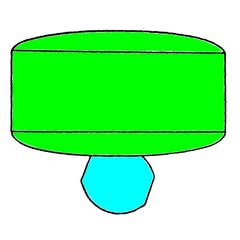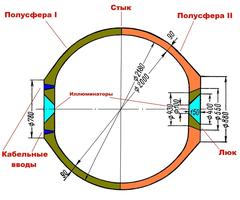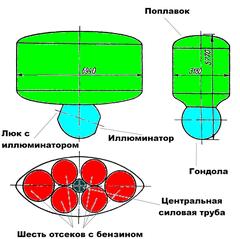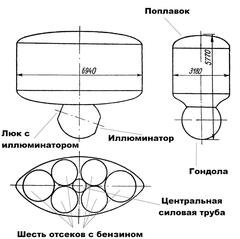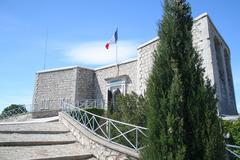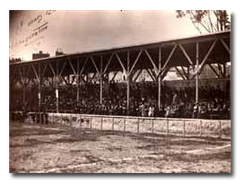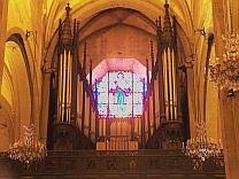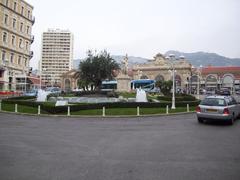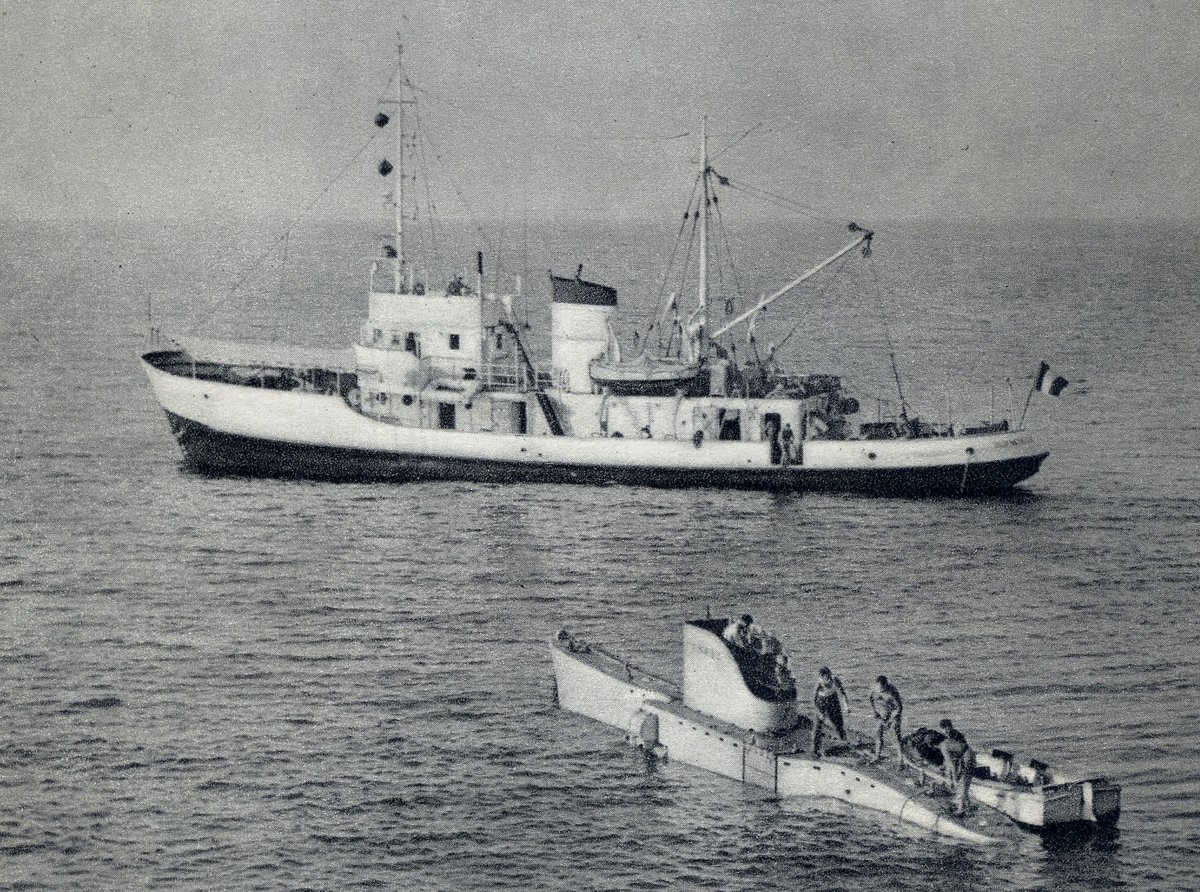
FNRS-3 Visiting Hours, Tickets, and Complete Guide to Toulon Historical Sites
Date: 14/06/2025
Introduction
The FNRS-3 bathyscaphe stands as an icon of deep-sea exploration and French maritime heritage. Built in Toulon, France, in the early 1950s through the collaboration of the French Navy, CNRS, and Belgium’s FNRS, it embodies scientific innovation and Franco-European partnership. Today, the FNRS-3 is displayed outdoors in the gardens of Toulon’s historic Tour Royale, offering visitors a direct link to a pivotal moment in oceanographic history. This comprehensive guide covers the FNRS-3’s historical significance, technical features, visiting hours, ticketing details, accessibility, nearby attractions, and practical travel tips to help you plan an enriching visit (Var Matin, Provence 7, ProvenceMed).
Contents
- Origins and Historical Context
- Construction and Technical Innovations
- The Historic 1954 Descent
- FNRS-3’s Legacy and Influence
- Cultural Significance in Toulon
- Preservation and Current Condition
- How to Visit: Hours, Tickets, and Access
- Travel Tips and Accessibility
- Nearby Attractions
- FAQs
- Conclusion and Planning Resources
Origins and Historical Context
The FNRS-3 story begins with Swiss physicist Auguste Piccard, renowned for his stratospheric balloon flights and inspiration for Hergé’s “Professor Calculus” in Tintin. Driven to explore Earth’s extremes, Piccard moved from the skies to the ocean’s depths. The bathyscaphe series—named after Belgium’s Fonds National de la Recherche Scientifique (FNRS)—evolved from the FNRS-1 balloon to the FNRS-2 and finally to the FNRS-3, which incorporated the pressure sphere from its predecessor into a new, robust vessel designed for deep dives (Var Matin).
Construction and Technical Innovations
Built between 1952 and 1953 in Toulon, the FNRS-3 was a collaboration between the French Navy (Marine nationale), the CNRS, DCAN, and the FNRS. Its most distinctive feature is the large gasoline-filled float, designed for optimal buoyancy, sitting above a spherical steel pressure hull that safely housed two crew members. The two-tone yellow and red exterior maximized surface visibility, and the vessel’s minimal yet effective life-support and navigation systems allowed unprecedented manned descents. Communication with the surface was limited to Morse code, emphasizing the risk and isolation of early deep-sea exploration (Var Matin, Provence 7).
The Historic 1954 Descent
On February 15, 1954, the FNRS-3 set a world record by descending to 4,050 meters off Dakar, Senegal. Captain Georges Houot and engineer Pierre Willm spent hours submerged, directly observing the abyssal seafloor and encountering bioluminescent life. This feat not only established a new depth record but also demonstrated the viability of direct human exploration in deep-ocean environments, breaking new scientific ground (Var Matin).
FNRS-3’s Legacy and Influence
The FNRS-3’s success inspired a new era of oceanography. Its design principles—gasoline float for buoyancy, robust pressure hull—became standard in subsequent submersibles, such as the Trieste (which reached the Mariana Trench in 1960) and the French Archimède. The FNRS-3’s contributions fostered international collaboration and advanced our understanding of deep-sea geology and biology (Provence 7).
Cultural Significance in Toulon
For Toulon, the FNRS-3 is both a technological marvel and a symbol of local pride. Displayed in the Tour Royale gardens overlooking the harbor, it attracts thousands of visitors annually and highlights Toulon’s enduring role in maritime innovation. The vessel’s presence celebrates the city’s naval traditions and honors the courage of its explorers (Var Matin).
Preservation and Current Condition
Outdoor exhibition has exposed the FNRS-3 to weather and corrosion. The last major restoration was in 2005, but recent assessments urge further conservation to prevent deterioration. While structurally stable for now, advocates recommend relocating the vessel to a sheltered museum environment for long-term preservation (Var Matin).
How to Visit: Hours, Tickets, and Access
Location
- FNRS-3 Bathyscaphe: Displayed outdoors in the gardens of the Tour Royale, Mourillon district, Toulon (ProvenceMed).
- Google Maps: Tour Royale Gardens (FNRS-3 Display)
Visiting Hours
- Gardens (FNRS-3 Display): Open daily, typically from 8:00 AM to 7:00 PM in summer, until 5:00 PM in winter. Hours may vary; check the Toulon city website for updates.
- FNRS-3 Admission: Free, no ticket required. The vessel is viewable year-round in daylight.
Tour Royale Fortress
- Interior access may require a ticket during special events or exhibitions. Check the official site or local tourism office for details.
Museums
- Musée National de la Marine: Nearby, offers broader maritime exhibits. Official ticketing site
Travel Tips and Accessibility
Getting There
- By Train: TGV to Toulon from Paris, Marseille, or Nice. From Gare de Toulon, take local buses (lines 3 or 23) to Mourillon.
- By Car: Use the A50 motorway; parking is available near Tour Royale but can be limited during busy periods.
- From Cruise Port: 2.5 km from the cruise terminal—reachable by taxi, bus, or a scenic walk (cruiseandsea.com).
Accessibility
- The gardens are mostly wheelchair accessible with paved paths, though some areas near the fortress may be uneven. Assistance is recommended for visitors with limited mobility.
Facilities
- Restrooms are available in the gardens and at Tour Royale.
- Benches and shaded areas offer comfort during your visit.
- Plenty of cafés and shops are located in the Mourillon district.
Nearby Attractions
Enhance your visit by exploring these Toulon highlights:
- Tour Royale: 16th-century fortress with panoramic harbor views.
- Musée National de la Marine: Comprehensive exhibits on French naval history.
- Mourillon Beaches: Sandy beaches a short walk from the gardens.
- Mont Faron: Cable car access to hiking and city vistas.
- Old Town Toulon: Markets, opera house, and historic architecture (thecrazytourist.com).
FAQs: Visiting the FNRS-3
Q: Are tickets required to view the FNRS-3?
A: No, the outdoor display in the Tour Royale gardens is free and open to the public.
Q: What are the visiting hours?
A: Generally 8:00 AM–7:00 PM (summer), 8:00 AM–5:00 PM (winter); check official resources for updates.
Q: Are guided tours available?
A: The FNRS-3 is self-guided. Guided tours of the Tour Royale and the Musée National de la Marine are available; inquire at the Toulon Tourist Office.
Q: Is the site family-friendly and accessible?
A: Yes, gardens are open and educational, though some uneven paths may challenge wheelchair users.
Q: Can I take photos?
A: Yes, personal photography is allowed. Please respect barriers and site rules.
Visual Highlights
- The FNRS-3’s striking yellow-red hull set against the historic Tour Royale.
- Panoramic views of Toulon harbor.
- Gardens and nearby Mourillon beaches.
Conclusion: Plan Your Visit
The FNRS-3 bathyscaphe offers an unparalleled window into the history of deep-sea exploration and Toulon’s maritime legacy. With free access, convenient location, and proximity to other cultural attractions, it is a must-visit for enthusiasts and families alike. For the best experience, check visiting hours, consider combining your trip with a museum tour, and use official resources for up-to-date information.
For further details, tickets for nearby museums, and events, visit:
Download the Audiala app for guided tours, audio guides, and up-to-date alerts about Toulon’s maritime heritage. Follow us on social media for more history and travel inspiration.
